I’ve always made games because it’s a passion of mine, and the game that best represents this is Tower of Greed. No other game I’ve created has brought me so much joy, either during the development process or after release. Today, I get the amazing opportunity to break down my own creation, and share with you everything from the game’s core design, to its biggest flaws, and how I plan to address them in a sequel.
I learned a tremendous amount developing and releasing this game when I was a part of Epic Shadow (Andrew Sandifer and myself), and it’s great to have the opportunity to share those lessons with you.
Play the Game
What do you like about the game? What would you change in a sequel?
How It Plays
Tower of Greed is quite simple in design, but with just a few simple mechanics thrown together properly, the results are amazing.

As the name suggests, the core mechanic of the game is greed. The secondary mechanic is of course that it’s a platformer. The object of the game is to climb the pseudo-randomly generated tower as high as possible, while collecting loot, without dying. The screen will automatically scroll once you leave the first “floor” of the tower (each “floor” is two screens high worth of level content) — if you fall too far below the screen, it’s game over.
There are various enemies throughout the tower, and while they can’t directly kill you, they will knock you back, often resulting in death. To defend yourself from them, you must either dodge, or grab an item sack to receive a random item to defend yourself with.
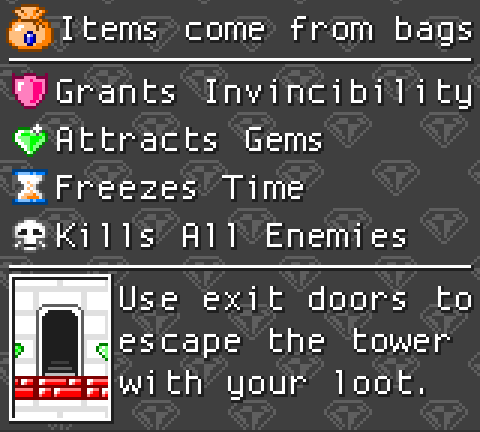
The catch, and where the element of greed comes into play, is that the only way to “win”, is to exit the tower by choice. Every 5th floor of the tower is a “door” map, which contains an exit from the tower. If you want to bank your achievements and submit your score, you have to exit one of these doors eventually, as death will result in losing everything, and the game goes on forever if you don’t exit.
Level Design
Level design is a crucial aspect of any platformer, and is one of the greatest strengths in Tower of Greed. We spent a lot of time thinking about how to do the levels, and eventually came up with an effective system.
Random Level Generation
As I mentioned, the levels in Tower of Greed are pseudo-randomly generated. There are 64 pre-designed maps; a few of these are “door” maps and “ground” maps, and the rest of them are designed to seamlessly flow together. In addition, there are various tiers of difficulty, and the game will grab maps from certain tiers depending on how high in the tower you are. The first floor of the tower is always a “bottom” map, which always has a floor, and a very easy layout. After that, you’ll receive randomly selected maps from your current difficulty tier, and receive a “door” map every fifth map.
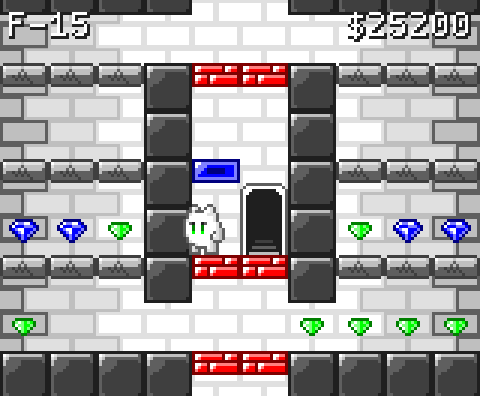
The main benefit to using pseudo-random generation is that we have complete control over how the maps are laid out — from enemy spawn points to where treasures are located. Additionally, the variation in maps experienced each game really helps keep things fresh, as you’ll experience something new even when replaying the first five floors over and over. Completely random generation (within rules applied to create sensible maps) would have been great, but it’s just impossible to compete with the level design that can be done manually, especially considering the complexity of object types.
The biggest flaw to this system, at least for Tower of Greed, is that eventually you start to remember the 64 maps that can be experienced. What is supposed to be an entirely new experience each play, while still unique to an extent, becomes overly familiar.
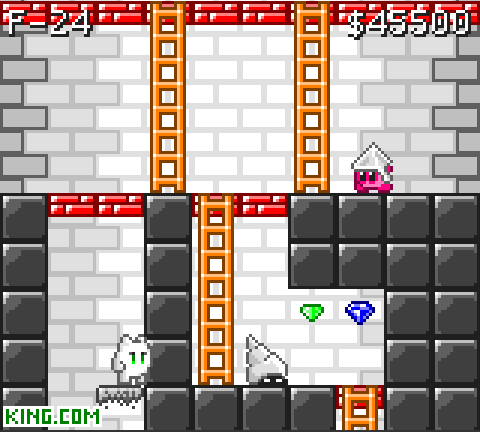
To address these issues, simply having more difficulty tiers — and more maps within each tier — would help. If the first five floors of the tower have 24 maps to choose from, rather than just eight or so, there’s going to be a lot more variety. Additionally, adding support for loading mirror-imaged maps would greatly increase the diversity.
It’s also important to note that most players will experience the first 10 or 20 floors far more than the later difficulty tiers, and so it’s perhaps best to add more diversity to the earlier tiers, to ensure things stay fresh.
Minor Annoyances, Begone!
While most of the game runs pretty smoothly, there are definitely a couple of annoyances that hindered how enjoyable the gameplay experience was. I was oblivious to these issues during development, but after reading a few hundred reviews, I’m now a step ahead of my former self.
The first major flaw of the game is that the camera doesn’t quite follow the player quickly enough. When you reach the top of the screen, the tower will scroll quicker, to allow you to see what’s up ahead. Unfortunately, this scroll isn’t quite fast enough, and it doesn’t kick in early enough.
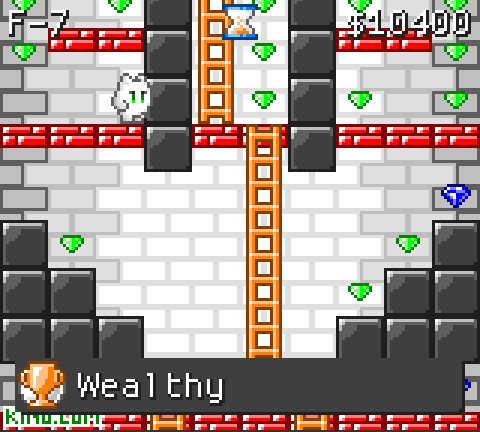
To address this issue in a sequel, I’d decrease how far up the tower you need to be in order to make the tower scroll faster, and I’d scroll at a speed that’s relative to how fast you climb, to ensure you never go off-screen.
The second flaw is that there’s a little too much luck and memorization required in order to do extremely well. Due to the previous issue, it was possible to get hit by enemies off screen, or have enemies quickly appear before you were ready for them. The only way to avoid some potentially deadly situations is to have the map memorized, which I feel is bad game design.
In the sequel, I’d focus on removing luck from the equation, which is mostly fixed with the previous solution. I’ll also ensure that if a new element is introduced, that all the early maps that use said element introduce it in a way that lets you know how it works, before you actually have to deal with it — a wonderful point that Egoraptor points out about Megaman X’s level design in this video:
Greed
Greed is intentionally the core mechanic in the game, and judging by the comments I’ve seen over the years, we succeeded in getting that point across.
Valuable loot was placed in extremely tempting (and dangerous) positions, which constantly encouraged the player to take a risk. Every “door” map had a pile of valuable loot just beyond a point of no return, forcing the player to almost always have a mini-debate on weather to go for it, or quit while they’re ahead. It’s this design that made it almost always the player’s fault when they died, as simply climbing the tower without focusing on loot is quite easy.
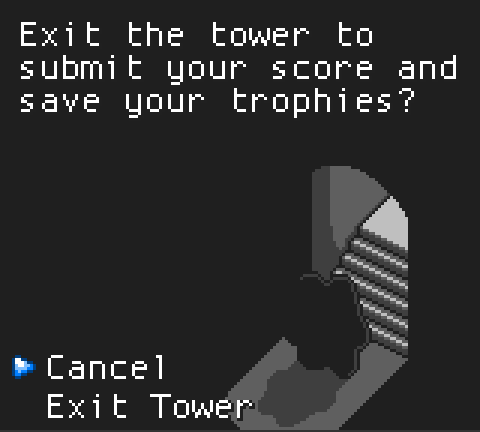
Even though the greed theme was executed well, there’s still significant room for improvement. One of the game’s biggest flaws, in my opinion, is that there are only three types of collectibles: common green gems, uncommon blue gems, and rare white gems. While this system works, it falls short of my original intentions. The idea was to constantly throw something new in front of the player, so that they’re always saying “just five more floors”.
In the sequel, I’d have 16 or more types of collectibles (using a shape / size / color system that’s easy to follow). This would allow me to place something the player has never seen before just above each door map, greatly tempting them to be greedy and continue their upward climb. In addition, some aesthetic changes I’ll mention in a moment would also play a part in tempting the player to continue onward.
Graphics
The art for Tower of Greed is immediately noticeable as a throwback to the NES era. Andrew was entirely responsible for the art, and the general consensus is that he did an amazing job capturing the retro feel. The game isn’t too art heavy, but what is there, is done excellently, and stays true to the era the game’s inspiration originates from.
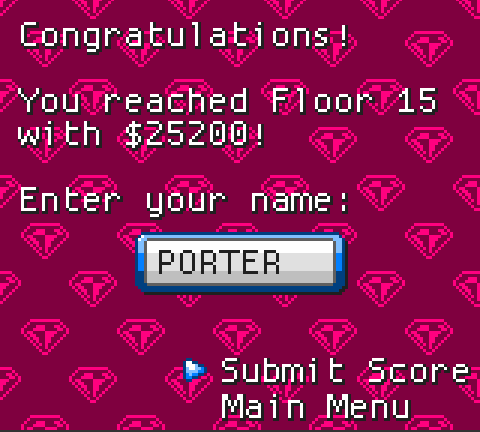
Even with the art being extremely well done, there’s plenty of room for improvement. Some of the animations on GEM (the character you play as) are a bit rough, or lacking in frames. At times it’s hard to tell if he’s actually animated — this is mostly due to his short round body, and the limited pixel count for his feet due to the 8-bit style.
The other area the art was lacking in is in details of the tower. (Okay, the art wasn’t really lacking per se, as it wasn’t in the original design, but it could be improved.) For the sequel, I’d address this lack of detail by opening up the back walls of the tower with windows, exposing the outdoors to the player. As you climb, you’d pass ground, tree tops, clouds, etc. Additionally, the insides of the tower would change as you reach higher difficulty tiers. These changes would add a lot more depth to the atmosphere of the tower, and really help emphasize the progression of the player, as well as add a sense of exploration as they reach higher levels.
Audio
The audio for Tower of Greed is also a throwback to the NES era, and is entirely 8-bit. The sound effects were created by me, using the audio freeware SFXR, alongside the freeware Audacity.
The music was composed specifically for the game, by my good friend Mike Taylor. He pulled off the 8-bit magic of the good old NES days brilliantly, and I feel that his custom music really lifted the polish of the game.
The music received an enormous amount of positive attention from players, with many asking for download links — one person even did a cover in Mario Paint. The lesson learned here: buy custom audio for your games, it’s very much worth it. While you can find music that is fitting for your game, nothing will ever beat music that is created specifically for your game, by someone who understands your game. Musicians are far too often left out of the equation for indie games (specifically web games), and it’s sad, because audio is not just extremely important, it’s crucial.
Conclusion
Releasing a successful game is no easy feat, but learning enormous amounts about the design of such a simple yet successful game is even harder. For me, Tower of Greed did just this. It may not have become the most popular game of all time on the web, but I’m quite content with the number of cult fans it has.
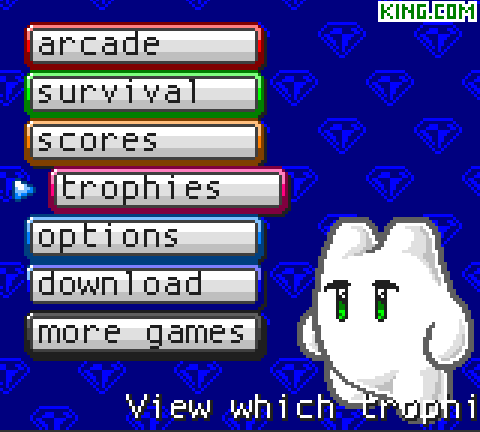
The target audience was those who grew up playing NES platformers, and those who love arcade style games, and we hit that target perfectly. I’ve released a number of games over the years, but Tower of Greed is the only one I still go back to play myself, as a gamer, because I honestly enjoy doing so. Targeting such a niche audience may not sound like such a smart move in an age where viral spread and mass views is crucial, but I have no regrets. I feel that when you pour your heart into a project that you truly believe in, then you not only achieve better results, but you also learn things that can’t be learned otherwise.